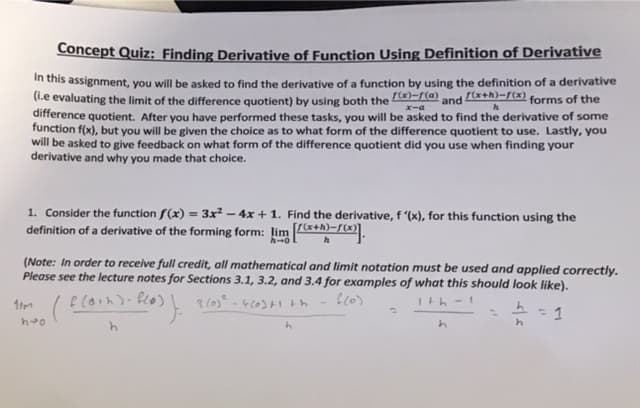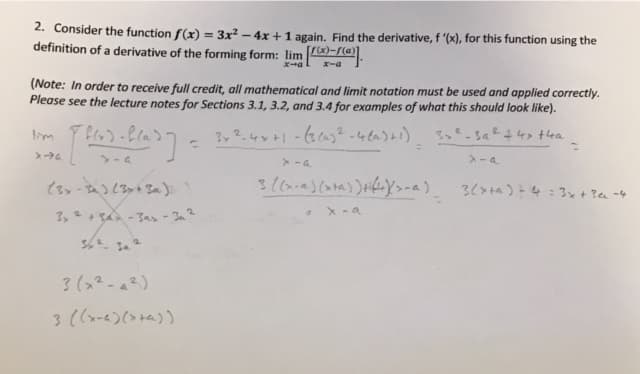Concept Quiz: Finding Derivative of Function Using Definition of Derivative In this assignment, you will be asked to find the derivative of a function by using the definition of a derivative (1.e evaluating the limit of the difference quotient) by using both the difference quotient. After you have performed these tasks, you will be asked to find the derivative of some function f(x), but you will be given the choice as to what form of the difference quotient to use. Lastly, you will be asked to give feedback on what form of the difference quotient did you use when finding your derivative and why you made that choice. Cx)-r(a) and forms of the X-a 1. Consider the function f(x) = 3x² – 4x + 1. Find the derivative, f (x), for this function using the definition of a derivative of the forming form: lim ath-/). (Note: In order to receive full credit, all mather Please see the lecture notes for Sections 3.1, 3.2, and 3.4 for examples of what this should look like). cal and limit notation must be used and applied correctly. = 1
Concept Quiz: Finding Derivative of Function Using Definition of Derivative In this assignment, you will be asked to find the derivative of a function by using the definition of a derivative (1.e evaluating the limit of the difference quotient) by using both the difference quotient. After you have performed these tasks, you will be asked to find the derivative of some function f(x), but you will be given the choice as to what form of the difference quotient to use. Lastly, you will be asked to give feedback on what form of the difference quotient did you use when finding your derivative and why you made that choice. Cx)-r(a) and forms of the X-a 1. Consider the function f(x) = 3x² – 4x + 1. Find the derivative, f (x), for this function using the definition of a derivative of the forming form: lim ath-/). (Note: In order to receive full credit, all mather Please see the lecture notes for Sections 3.1, 3.2, and 3.4 for examples of what this should look like). cal and limit notation must be used and applied correctly. = 1
Calculus: Early Transcendentals
8th Edition
ISBN:9781285741550
Author:James Stewart
Publisher:James Stewart
Chapter1: Functions And Models
Section: Chapter Questions
Problem 1RCC: (a) What is a function? What are its domain and range? (b) What is the graph of a function? (c) How...
Related questions
Question
I found the limit of the function using the two methods it asked for and they yielded different functions. Is it okay for them to result in different functions?

Transcribed Image Text:Concept Quiz: Finding Derivative of Function Using Definition of Derivative
in this assignment, you will be asked to find the derivative of a function by using the definition of a derivative
(i.e evaluating the limit of the difference quotient) by using both the
difference quotient. After you have performed these tasks, you will be asked to find the derivative of some
function f(x), but you will be given the choice as to what form of the difference quotient to use. Lastly, you
will be asked to give feedback on what form of the difference quotient did you use when finding your
derivative and why you made that choice.
r(x)-r(a)
and Cx+h)-f(x) forms of the
エーa
1. Consider the function f(x) = 3x² – 4x + 1. Find the derivative, f '(x), for this function using the
definition of a derivative of the forming form: lim *+h)-/(x).
(Note: In order to receive full credit, all mathematical and limit notation must be used and applied correctly.
Please see the lecture notes for Sections 3.1, 3.2, and 3.4 for examples of what this should look like).
e (oいn)- Pco)
3 (0s
Ith - 1
-4)ト1
= 1

Transcribed Image Text:2. Consider the function f(x) = 3x² – 4x + 1 again. Find the derivative, f '(x), for this function using the
definition of a derivative of the forming form: lim -@.
エーロ
(Note: In order to receive full credit, all mathematical and limit notation must be used and applied correctly.
Please see the lecture notes for Sections 3.1, 3.2, and 3.4 for examples of what this should look like).
>-a
31-m)(aa))+4)y>-a) 3<xa) 4:3ン+Ta-4
3,2+ A - 3as -3a?
X - a
3(22-42)
Expert Solution
Step 1
The given function is
f(x) = 3x2 - 4x + 1
Now to find the derivative by using definition.
Trending now
This is a popular solution!
Step by step
Solved in 3 steps

Knowledge Booster
Learn more about
Need a deep-dive on the concept behind this application? Look no further. Learn more about this topic, calculus and related others by exploring similar questions and additional content below.Recommended textbooks for you

Calculus: Early Transcendentals
Calculus
ISBN:
9781285741550
Author:
James Stewart
Publisher:
Cengage Learning

Thomas' Calculus (14th Edition)
Calculus
ISBN:
9780134438986
Author:
Joel R. Hass, Christopher E. Heil, Maurice D. Weir
Publisher:
PEARSON

Calculus: Early Transcendentals (3rd Edition)
Calculus
ISBN:
9780134763644
Author:
William L. Briggs, Lyle Cochran, Bernard Gillett, Eric Schulz
Publisher:
PEARSON

Calculus: Early Transcendentals
Calculus
ISBN:
9781285741550
Author:
James Stewart
Publisher:
Cengage Learning

Thomas' Calculus (14th Edition)
Calculus
ISBN:
9780134438986
Author:
Joel R. Hass, Christopher E. Heil, Maurice D. Weir
Publisher:
PEARSON

Calculus: Early Transcendentals (3rd Edition)
Calculus
ISBN:
9780134763644
Author:
William L. Briggs, Lyle Cochran, Bernard Gillett, Eric Schulz
Publisher:
PEARSON

Calculus: Early Transcendentals
Calculus
ISBN:
9781319050740
Author:
Jon Rogawski, Colin Adams, Robert Franzosa
Publisher:
W. H. Freeman


Calculus: Early Transcendental Functions
Calculus
ISBN:
9781337552516
Author:
Ron Larson, Bruce H. Edwards
Publisher:
Cengage Learning